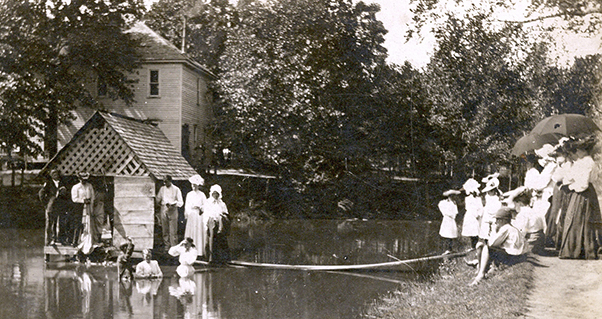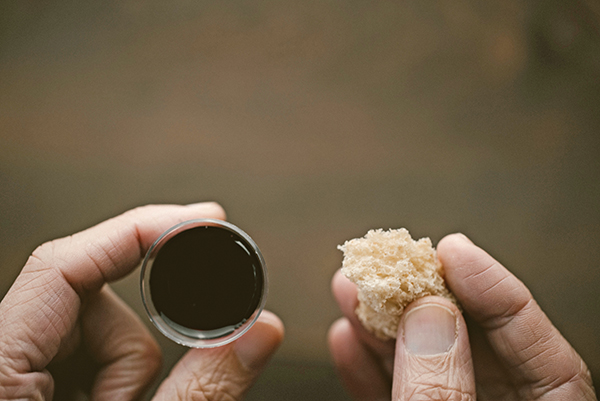Written by Stan Ingersol
Past to Present
Baptism and Eucharist are dear to the hearts of Christians. Sacramental moments are often very precious and can be occasions of deep meaning and great joy.
Christian Baptism

candidates in a creek around 1904.
Phineas Bresee routinely baptized infants and small children. In his early ministry, the Methodist Discipline required him to organize all baptized children into classes and arrange suitable teachers to guide them in their discipleship development. Later, as a Nazarene, Bresee frequently baptized infants at district assemblies. Alan Bresee Smith of Ponca City, Okla., was one of these. He later relayed the story of his baptism passed on to him by his mother:
“The date of my baptism was November 14, 1914 . . . at a district assembly in Bethany, Oklahoma, where Bresee was presiding . . . . Unexpectedly, right in the middle of things, the obstreperous 15-month-old kid began to flail his arms and legs about and to yell bloody murder. Bresee, a frail old man, was unflappable and fully equal to the occasion. He was sitting in a chair. Placing the child firmly between his knees, he baptized him.” Despite the child’s infant protest, he grew to be a fine Christian, and after service in World War II, entered seminary and became a Presbyterian pastor.1
E. A. Girvin, Bresee’s first biographer, wrote that Bresee’s “conduct of the baptismal service was especially helpful and edifying. He emphasized the duties and privileges of parents in rearing their children in the nurture and admonition of the Lord, and gave a beautiful exposition of the real spiritual significance of the ordinance of baptism. After performing the actual rite, he would take the little children in his arms and kiss them. This he did so lovingly that the hearts of the parents were always moved.”2
Still, even for Bresee, the venues for Christian baptism could vary widely. He baptized one man in a church board meeting and others in the Pacific Ocean’s surf on several occasions.3
Others also found varied venues. In 1907, six students at Pentecostal Collegiate Institute (forerunner of Eastern Nazarene College) were baptized on Sunday at a lake near the school. It was commencement weekend, and this was one of several activities marking the end of the school year.4
F. W. Domina reported that holiness people from churches in several Massachusetts towns had gathered in Dennisport to enjoy victorious worship. In the afternoon, they “had a most impressive baptismal service at the sea shore, when three candidates confessed their faith in the glorious doctrines of the atonement in the presence of hundreds of spectators.”5 Six weeks later, the church in South Providence, RI, “had a baptism by immersion at the river.”6
In 1932, at the conclusion of revival services in Canton, Ill., Pastor John Edge reported: “We had three baptismal services, one by sprinkling and two by immersion, and 57 followed the Lord in this ordinance.”7
Holy Communion

The Methodist Discipline required quarterly communion at a minimum, but often the minimum was also the maximum. Nazarene churches that hewed most closely to Methodism tended to retain that schedule. The standard of quarterly communion was enshrined in our Manual, but early Nazarenes in the northeast United States were influenced by the culture of the Congregational Church and tended to observe the Eucharist more frequently.
The church in Beverly, Mass., routinely observed the sacrament of Holy Communion on the first Sunday of the month. Margaret Waldie described these occasions as “times of special refreshing from the presence of the Lord.” In Lynn, Mass., pastor D. Rand Pierce also provided the sacrament monthly to his flock.8
Holiness folks in West Somerville, Mass., received eight new members into their church fellowship during the three o’clock communion service one Sunday.9
The sacrament could be received in places other than the local church. Henry Elsner reported in 1907 that the Allentown Camp meeting in Pennsylvania held a communion service at nine o’clock on Sunday morning and that “about two hundred souls” took part.10 Bresee opened the Southern California District’s 1909 assembly with a communion service.
This culture set the stage for the communion service at General Assembly. The First General Assembly, held in Chicago in 1907, began with a morning worship service conducted by Rev. C. V. La Fontaine of Los Angeles. That afternoon, Phineas Bresee took charge of the meeting and, after a few “well-chosen words, proceeded to administer the emblems in what proved to be a most spiritual communion service in which hundreds participated.”11 The pattern repeated when the Second General Assembly was held in Pilot Point, Tex., the following year.
Over the next century, tens of thousands of Nazarenes experienced Holy Communion at a General Assembly.
Stan Ingersol is manager of archives for the Church of the Nazarene.
1Letter of Alan Bresee Smith to Stan Ingersol, Aug. 31, 1989.
2E. A. Girvin, Phineas F. Bresee: A Prince in Israel (1916): 38.
3Carl Bangs, Phineas F. Bresee: His Life in Methodism, the Holiness Movement, and the Church of the Nazarene (1995): 233.
4Beulah Christian (June 15, 1907): 11.
5Beulah Christian (June 22, 1907): 13.
6Beulah Christian (August 10, 1907): 11.
7Herald of Holiness (Sept. 14, 1932): 27.
8Beulah Christian (Dec. 1, 1904): 16; and (Feb 16, 1907): 15.
9Beulah Christian (Feb 17, 1906): 15.
10Beulah Christian (August 17, 1907): 14.
11Beulah Christian (Oct. 19, 1907): 4.
